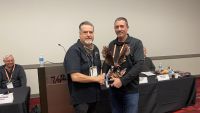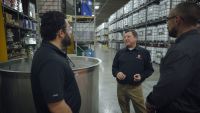Contractor to Contractor: Superior Waterproofing and Restoration Co. Inc.
By Masonry
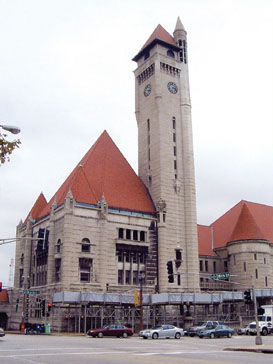 St. Louis Union Station tower restoration |
Thomas Schmitt founded Superior Waterproofing and Restoration Co. Inc. on two vital philosophies: always do the right thing and never take a project that his company could not handle. Over the past 27 years, after much patience and persistence, Superior has grown into a first-rate waterproofing and restoration company, with clients such as Anheuser-Busch, Pfizer, St. Louis University, Nestlé USA and a host of others. Schmitt took time to sit down with Masonry and share the keys to his company's growth and success, where he thinks the masonry industry is heading, and the vast array of services his company provides.
Masonry: Tell us a little more about Superior Waterproofing's history.
Schmitt: I started the company myself in 1979. I was a laborer for a larger company at that time. It started in a way that I am sure you've heard before - I got mad at my boss and quit; however, I always kind of dreamed of having a small company with a truck and a couple of helpers. I was rather young and naive; I was only 20 years old.
I started out basically in the residential market. My [company's] name says waterproofing and restoration, and I primarily started out just waterproofing homes and basements, with some small commercial. Some years later, I added the 'Restoration' part to the company name. It was an evolutionary process. In about 1986 and 1987, I got more into the masonry aspect of things and went strictly commercial. We went union; that provided more opportunity in the commercial markets here in the Midwest, which changed everything on that front.
It may sound slow, but it was really one or two jobs at a time that helped us grow. We did not take what we could not do well. You don't make a lot of money overnight. We're in our 28th season, so I guess something's worked so far.
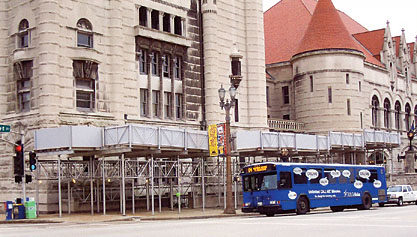 St. Louis Union Station tower restoration |
Schmitt: Literally, doing the right thing. So many people I've seen through the years have come and gone; they're trying to make a fast buck. Some people are not necessarily dishonest, but a few are putting out a bad product.
Everybody has problems in their business. You're going to have problems, it's just how well you take care of them and stand behind what you do, and we always did that. Like I said, don't take what you can't facilitate. We did it right, took care of it, and had a lot of pride in what we did.
And being small and starting small, it was easy to create a good nucleus of people. It's an ongoing process that every company goes through - trying to find the best people for the project.
Finally, don't burn any bridges; you might have to come back across them.
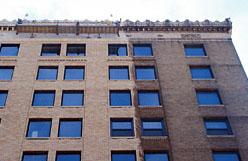 St. Louis loft district masonry restoration and cleaning |
Schmitt: The word "waterproofing" is a huge part of the restoration process. People don't think of tuckpointing, restoration and things like that in terms of waterproofing until they have leaks, interior damage and building façade failures.
Often on the older masonry structures - and the newer ones - the first signs that they have leaks are the plaster is peeling and flaking, there's water dripping at the window heads, and so forth. It comes into the building skin and, at that point, it's a masonry issue. It then becomes apparent that there are issues with the building façade. The problems become many, for instance, tuckpointing, sealant failures, loss of brick or stone integrity, deterioration of building surfaces, and design flaws.
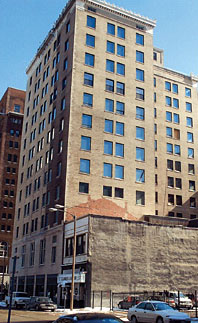 St. Louis loft district masonry restoration and cleaning |
Masonry: Your website mentions the company's "commitment to extensive evaluation and diagnosis." Please explain what steps you take for each client to fulfill this commitment.
Schmitt: It's changed a little bit recently, but for 25 years, we were owner-direct. We did not do a lot of work with general contractors in the bid world. We were on the street developing the accounts with the hospitals, universities, government and what have you. They would rely on us, and still do. If they have a problem, they call us, or if they have budget plans to create, we help prepare such.
A lot of the large organizations have a lot more long-range planning, so they'll look at a building and determine its needs over an extended period of time. That's what we do; we go in, talk to the owner and ask, "What are your goals? What are you trying to achieve?" Obviously, money dictates, as it does with everything. Everyone would like to buy a Rolls-Royce, but most people can't.
We will first evaluate the structure and let the owner know what they are up against. Our job is to let them know the full extent of the conditions that exist on the building façade. So then you talk to them and find out if they're having any specific problems - if there are specific target areas, if there's something going on inside where they're having trouble with leaks, or if parts of the building exterior are in jeopardy of falling off. Maybe they just want to keep their building in excellent shape with preventative maintenance.
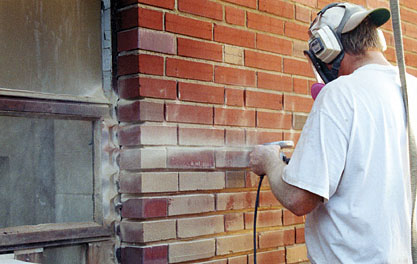 General repointing of Webster Groves High School |
Another big part of our success is that we provide emergency repair work. We can generally facilitate our customer's serious emergency repairs within days. We also find dealing direct with owners provides expediency for them and us, as well as a cost savings for them. There's no 'in between,' like with general contractors. We pride ourselves on that, and a great deal of our customer base is ongoing. We keep those relationships and value them highly. Many of my customers have been using Superior for over 20 years. I believe that says a lot about the trust and quality we provide.
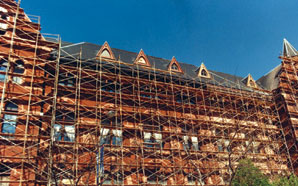 DuBourg Hall, St. Louis University |
Schmitt: There was a transformation for me back in '87 and '88. One of the big pivotal things was my father coming on board. He worked for the company that I left in '79. My dad was a sales manager there for around 30 years and, needless to say, left for various reasons. He came to me one day and said, 'How about I work for you?' I told him I couldn't afford him, but he was in a position financially and at a time in his life where he really wanted to freelance. So he opened doors for me that were always there, but I didn't know how to open. Because I was so young, he brought a little 'gray hair' [to the business], which goes a long way. So he was on the sidelines opening a lot of doors.
People buy from people. You can buy a brick from anybody, but it's how it's put in and who's going to stand behind it. My father was very well liked in the industry and it changed things tremendously. It gave me a lot of confidence.
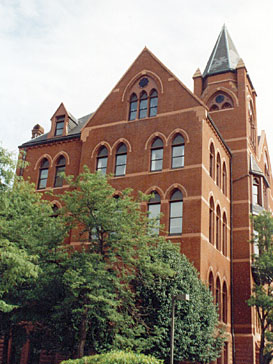 DuBourg Hall, St. Louis University |
Masonry: Looking back over the years, what were a few of your most challenging projects and how did you overcome the obstacles?
Schmitt: The first and foremost thing that comes to mind is St. Louis University's DuBourg Hall. This was a 103-year structure at the time, with heavy sandstone ornamentation that had been just let go for years. There were no profiles left on these stones, aside from the brick and the tuckpointing. It was a huge job for us at the time. ...
The beauty of that project was that the owners of the university knew what they were up against, so the financial constraints were there, but with the understanding of what they had to do. We had to bid it, but when we crossed a problem, they realized it and they went the distance. On a historical restoration like that, our job was to not only restore the utility value of the building skin, but also restore its former glory. We'd get up there and there would be stones four feet long that would just crumble. And the owners understood that and were willing to go the distance. ...
Often the hard part on some of the bigger, historical projects is when you first look at it, you're overwhelmed. It's putting your costs together that's the hard part. Until you hang a building or get up on it, you have no way of knowing how much stone is loose, how much stone is in jeopardy of falling, how many pieces are going to crumble in your hand. So, you come up with a basic scope and then develop unit costs. The owner has to be very open to the fact that he may get a half-million-dollar bid, and then get a $250,000 change order. You have to tell people this going in; you can't surprise them. There has to be a lot of trust in the relationship between the contractor and the owner that you're going to do the right thing - that you're not going to take advantage of the situation.
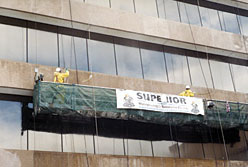 St. Clair county courthouse, Belleville, Ill. |
Schmitt: Maybe costs related to other [building systems]. I once had a friend who built a house with siding, and he said, 'You know what? For another buck, I would've put brick on it.' I guess that might be the one misconception.
Masonry: What is your biggest concern in keeping your company successful?
Schmitt: We have a shortage of qualified people up here. I had travelers in for the first time ever this year. I had people from Chicago, Kansas City, Mo., and Springfield, Ill., up here working for us. I can't say enough about it. It's just really hard to find people who care and who are qualified, trained and want to learn, and want to be responsible for what they do.
That is our constant, No. 1 battle in this company. No longer is it to get the work. No longer is it the administrative aspects, logistics or equipment. It's to find people that care - people that you trust will do the work. We're constantly going through the pool. For every 10, we're lucky if we can find one or two keepers. That's our continuing battle.
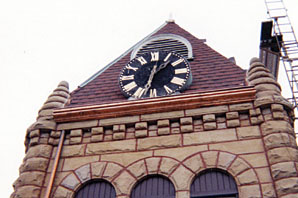 Full masonry restoration of Jersey county courthouse in Illinois |
Schmitt: Precast. EIFS is also getting bigger and bigger in this area as well. I know it's big down south and has its place. There have been a lot of problems and a lot of success with it, and it's still going up for reasons of cost and, I suppose, insulation values. It seems to be working. I am just not sure for how long as opposed to masonry.
We're getting a new stadium in St. Louis; they came in and used these simulated brick panels that are precast. I've got to tell you, driving down the street, you can't tell it's concrete. I think things like that are getting so much better. And, again, it's always going to come down to cost.
Masonry: What do you feel are the most critical issues you'll face with future government regulations?
Schmitt: For my industry, it's going to be the silica issue. I'm on a committee with mason contractors here and that thing could be explosive. I don't know where it all stands, but I see it being huge. If the things in that standard come about ... wow! It's not just going to affect the brick business. Anybody who takes a concrete saw or broom - and those costs that would be thrown onto the contractors - and eventually the consumers - would be absolutely huge.
Masonry: What do you like most about being a member of MCAA?
Schmitt: The networking aspect - just being involved locally with other contractors and trading ideas. We're all friends and everybody gets along. We trade ideas and stay in touch with one another - keep everyone abreast on what's going on.
Collectively, hopefully, we can force some change, like with the silica issues. We're all equally concerned. We all have an equal stake.
About the Author
Masonry, the official publication of the Mason Contractors Association of America, covers every aspect of the mason contractor profession - equipment and techniques, building codes and standards, business planning, promoting your business, legal issues and more. Read or subscribe to Masonry magazine at www.masonrymagazine.com.












